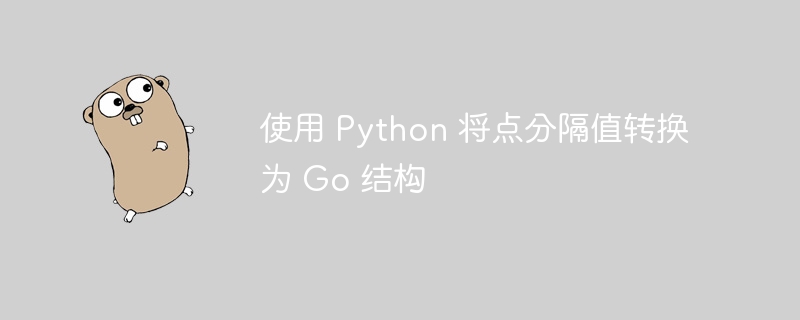使用 Python 將點分隔值轉換為 Go 結構

php小編柚子在本文中將介紹如何使用Python將點分隔值(如"key1.subkey1.subkey2")轉換為Go語言中的結構體。這個轉換過程對於從設定檔或API回應中提取和處理資料非常有用。我們將使用Python的遞歸函數和Go語言的結構體來實現這個轉換,並給出詳細的程式碼範例和解釋。透過本文的學習,讀者將能夠輕鬆處理和轉換點分隔值,提高資料處理的效率和靈活性。
問題內容
這是對可以更改配置的應用程式的特定要求(特別是 wso2 identity server,因為我正在使用 go 為其編寫 kubernetes 運算子)。但這裡確實不相關。我想創建一個解決方案,允許輕鬆管理大量配置映射以產生 go 結構。這些配置映射在 .csv 中
連結到 .csv - my_configs.csv
我想要, 編寫一個自動產生 go 結構的 python 腳本,這樣對應用程式配置的任何變更都可以透過簡單地執行 python 腳本來建立相應的 go 結構來更新。我指的是應用程式本身的配置。例如,可以變更 csv 中的 toml 鍵名稱/可以新增值。
到目前為止,我已經成功創建了一個 python 腳本,幾乎實現了我的目標。腳本是,
import pandas as pd
def convert_to_dict(data):
result = {}
for row in data:
current_dict = result
for item in row[:-1]:
if item is not none:
if item not in current_dict:
current_dict[item] = {}
current_dict = current_dict[item]
return result
def extract_json_key(yaml_key):
if isinstance(yaml_key, str) and '.' in yaml_key:
return yaml_key.split('.')[-1]
else:
return yaml_key
def add_fields_to_struct(struct_string,go_var,go_type,json_key,toml_key):
struct_string += str(go_var) + " " + str(go_type) + ' `json:"' + str(json_key) + ',omitempty" toml:"' +str(toml_key) + '"` ' + "\n"
return struct_string
def generate_go_struct(struct_name, struct_data):
struct_name="configurations" if struct_name == "" else struct_name
struct_string = "type " + struct_name + " struct {\n"
yaml_key=df['yaml_key'].str.split('.').str[-1]
# base case: generate fields for the current struct level
for key, value in struct_data.items():
selected_rows = df[yaml_key == key]
if len(selected_rows) > 1:
go_var = selected_rows['go_var'].values[1]
toml_key = selected_rows['toml_key'].values[1]
go_type=selected_rows['go_type'].values[1]
json_key=selected_rows['json_key'].values[1]
else:
go_var = selected_rows['go_var'].values[0]
toml_key = selected_rows['toml_key'].values[0]
go_type=selected_rows['go_type'].values[0]
json_key=selected_rows['json_key'].values[0]
# add fields to the body of the struct
struct_string=add_fields_to_struct(struct_string,go_var,go_type,json_key,toml_key)
struct_string += "}\n\n"
# recursive case: generate struct definitions for nested structs
for key, value in struct_data.items():
selected_rows = df[yaml_key == key]
if len(selected_rows) > 1:
go_var = selected_rows['go_var'].values[1]
else:
go_var = selected_rows['go_var'].values[0]
if isinstance(value, dict) and any(isinstance(v, dict) for v in value.values()):
nested_struct_name = go_var
nested_struct_data = value
struct_string += generate_go_struct(nested_struct_name, nested_struct_data)
return struct_string
# read excel
csv_file = "~/downloads/my_configs.csv"
df = pd.read_csv(csv_file)
# remove rows where all columns are nan
df = df.dropna(how='all')
# create the 'json_key' column using the custom function
df['json_key'] = df['yaml_key'].apply(extract_json_key)
data=df['yaml_key'].values.tolist() # read the 'yaml_key' column
data = pd.dataframe({'column':data}) # convert to dataframe
data=data['column'].str.split('.', expand=true) # split by '.'
nested_list = data.values.tolist() # convert to nested list
data=nested_list
result_json = convert_to_dict(data) # convert to dict (json)
# the generated co code
go_struct = generate_go_struct("", result_json)
# write to file
file_path = "output.go"
with open(file_path, "w") as file:
file.write(go_struct)問題是(查看 csv 的下面部分),
authentication.authenticator.basic authentication.authenticator.basic.parameters authentication.authenticator.basic.parameters.showAuthFailureReason authentication.authenticator.basic.parameters.showAuthFailureReasonOnLoginPage authentication.authenticator.totp authentication.authenticator.totp.parameters authentication.authenticator.totp.parameters.showAuthFailureReason authentication.authenticator.totp.parameters.showAuthFailureReasonOnLoginPage authentication.authenticator.totp.parameters.encodingMethod authentication.authenticator.totp.parameters.timeStepSize
這裡,由於 basic 和 totp 欄位 parameters 重複,因此腳本會混淆自身並產生兩個 totpparameters 結構。預期結果是具有 basicparameters 和 totpparameters 結構。 csv 的 yaml_key 欄位中存在許多類似的重複單字。
我知道這與 go_var = selected_rows['go_var'].values[1] 中索引被硬編碼為 1 有關,但很難修復此問題。
有人可以指點我一個答案嗎?我認為,
- 遞迴函數的問題
- 產生 json 的程式碼有問題 可能是此問題的根本原因。
謝謝!
我也嘗試過使用 chatgpt,但由於這與巢狀和遞歸有關,因此 chatgpt 提供的答案不是很有效。
更新
我發現包含 properties、pooloptions、endpoint 和 parameters 欄位的行有問題。這是因為它們在 yaml_key 欄位中重複。
解決方法
我能夠解決這個問題。但是,我必須完全使用一種新方法來解決問題,即使用樹資料結構,然後遍歷它。這是背後主要的邏輯 - https://www.geeksforgeeks.org/level-順序樹遍歷/
這是工作的python程式碼。
import pandas as pd
from collections import deque
structs=[]
class TreeNode:
def __init__(self, name):
self.name = name
self.children = []
self.path=""
def add_child(self, child):
self.children.append(child)
def create_tree(data):
root = TreeNode('')
for item in data:
node = root
for name in item.split('.'):
existing_child = next((child for child in node.children if child.name == name), None)
if existing_child:
node = existing_child
else:
new_child = TreeNode(name)
node.add_child(new_child)
node = new_child
return root
def generate_go_struct(struct_data):
struct_name = struct_data['struct_name']
fields = struct_data['fields']
go_struct = f"type {struct_name} struct {{\n"
for field in fields:
field_name = field['name']
field_type = field['type']
field_default_val = str(field['default_val'])
json_key=field['json_key']
toml_key=field['toml_key']
tail_part=f"\t{field_name} {field_type} `json:\"{json_key},omitempty\" toml:\"{toml_key}\"`\n\n"
if pd.isna(field['default_val']):
go_struct += tail_part
else:
field_default_val = "\t// +kubebuilder:default:=" + field_default_val
go_struct += field_default_val + "\n" + tail_part
go_struct += "}\n\n"
return go_struct
def write_go_file(go_structs, file_path):
with open(file_path, 'w') as file:
for go_struct in go_structs:
file.write(go_struct)
def create_new_struct(struct_name):
struct_name = "Configurations" if struct_name == "" else struct_name
struct_dict = {
"struct_name": struct_name,
"fields": []
}
return struct_dict
def add_field(struct_dict, field_name, field_type,default_val,json_key, toml_key):
field_dict = {
"name": field_name,
"type": field_type,
"default_val": default_val,
"json_key":json_key,
"toml_key":toml_key
}
struct_dict["fields"].append(field_dict)
return struct_dict
def traverse_tree(root):
queue = deque([root])
while queue:
node = queue.popleft()
filtered_df = df[df['yaml_key'] == node.path]
go_var = filtered_df['go_var'].values[0] if not filtered_df.empty else None
go_type = filtered_df['go_type'].values[0] if not filtered_df.empty else None
if node.path=="":
go_type="Configurations"
# The structs themselves
current_struct = create_new_struct(go_type)
for child in node.children:
if (node.name!=""):
child.path=node.path+"."+child.name
else:
child.path=child.name
filtered_df = df[df['yaml_key'] == child.path]
go_var = filtered_df['go_var'].values[0] if not filtered_df.empty else None
go_type = filtered_df['go_type'].values[0] if not filtered_df.empty else None
default_val = filtered_df['default_val'].values[0] if not filtered_df.empty else None
# Struct fields
json_key = filtered_df['yaml_key'].values[0].split('.')[-1] if not filtered_df.empty else None
toml_key = filtered_df['toml_key'].values[0].split('.')[-1] if not filtered_df.empty else None
current_struct = add_field(current_struct, go_var, go_type,default_val,json_key, toml_key)
if (child.children):
# Add each child to the queue for processing
queue.append(child)
go_struct = generate_go_struct(current_struct)
# print(go_struct,"\n")
structs.append(go_struct)
write_go_file(structs, "output.go")
csv_file = "~/Downloads/my_configs.csv"
df = pd.read_csv(csv_file)
sample_data=df['yaml_key'].values.tolist()
# Create the tree
tree = create_tree(sample_data)
# Traverse the tree
traverse_tree(tree)
非常感謝您的幫忙!
以上是使用 Python 將點分隔值轉換為 Go 結構的詳細內容。更多資訊請關注PHP中文網其他相關文章!

熱AI工具

Undresser.AI Undress
人工智慧驅動的應用程序,用於創建逼真的裸體照片

AI Clothes Remover
用於從照片中去除衣服的線上人工智慧工具。

Undress AI Tool
免費脫衣圖片

Clothoff.io
AI脫衣器

Video Face Swap
使用我們完全免費的人工智慧換臉工具,輕鬆在任何影片中換臉!

熱門文章

熱工具

記事本++7.3.1
好用且免費的程式碼編輯器

SublimeText3漢化版
中文版,非常好用

禪工作室 13.0.1
強大的PHP整合開發環境

Dreamweaver CS6
視覺化網頁開發工具

SublimeText3 Mac版
神級程式碼編輯軟體(SublimeText3)
 在Go語言中使用Redis Stream實現消息隊列時,如何解決user_id類型轉換問題?
Apr 02, 2025 pm 04:54 PM
在Go語言中使用Redis Stream實現消息隊列時,如何解決user_id類型轉換問題?
Apr 02, 2025 pm 04:54 PM
Go語言中使用RedisStream實現消息隊列時類型轉換問題在使用Go語言與Redis...
 GoLand中自定義結構體標籤不顯示怎麼辦?
Apr 02, 2025 pm 05:09 PM
GoLand中自定義結構體標籤不顯示怎麼辦?
Apr 02, 2025 pm 05:09 PM
GoLand中自定義結構體標籤不顯示怎麼辦?在使用GoLand進行Go語言開發時,很多開發者會遇到自定義結構體標籤在�...
 Go的爬蟲Colly中Queue線程的問題是什麼?
Apr 02, 2025 pm 02:09 PM
Go的爬蟲Colly中Queue線程的問題是什麼?
Apr 02, 2025 pm 02:09 PM
Go爬蟲Colly中的Queue線程問題探討在使用Go語言的Colly爬蟲庫時,開發者常常會遇到關於線程和請求隊列的問題。 �...
 Go語言中用於浮點數運算的庫有哪些?
Apr 02, 2025 pm 02:06 PM
Go語言中用於浮點數運算的庫有哪些?
Apr 02, 2025 pm 02:06 PM
Go語言中用於浮點數運算的庫介紹在Go語言(也稱為Golang)中,進行浮點數的加減乘除運算時,如何確保精度是�...
 在 Go 語言中,為什麼使用 Println 和 string() 函數打印字符串會出現不同的效果?
Apr 02, 2025 pm 02:03 PM
在 Go 語言中,為什麼使用 Println 和 string() 函數打印字符串會出現不同的效果?
Apr 02, 2025 pm 02:03 PM
Go語言中字符串打印的區別:使用Println與string()函數的效果差異在Go...
 Go語言中哪些庫是由大公司開發或知名的開源項目提供的?
Apr 02, 2025 pm 04:12 PM
Go語言中哪些庫是由大公司開發或知名的開源項目提供的?
Apr 02, 2025 pm 04:12 PM
Go語言中哪些庫是大公司開發或知名開源項目?在使用Go語言進行編程時,開發者常常會遇到一些常見的需求,�...
 Go語言中`var`和`type`關鍵字定義結構體的區別是什麼?
Apr 02, 2025 pm 12:57 PM
Go語言中`var`和`type`關鍵字定義結構體的區別是什麼?
Apr 02, 2025 pm 12:57 PM
Go語言中結構體定義的兩種方式:var與type關鍵字的差異Go語言在定義結構體時,經常會看到兩種不同的寫法:一�...







